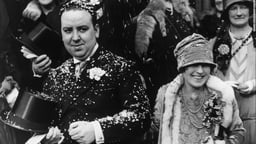Alfred Hitchcock
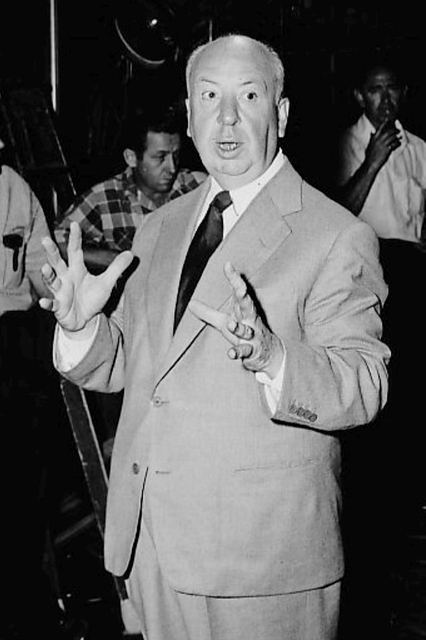
Alfred Hitchcock

Sir Alfred Hitchcock KBE | |
|---|---|
| Born | Alfred Joseph Hitchcock (1899-08-13)13 August 1899 Leytonstone, Essex, England |
| Died | 29 April 1980(1980-04-29)(aged 80) Bel Air, California, United States |
| Citizenship | British United States (from 1955) |
| Education | Salesian College, Battersea |
| Alma mater | St Ignatius' College, London |
| Occupation |
|
| Years active | 1919–1980 |
| Spouse(s) | Alma Reville (m. 1926) |
| Children | Patricia Hitchcock |
| Awards | List of awards and nominations received by Alfred Hitchcock |
| Website | alfredhitchcock.com [241] |
Sir Alfred Joseph Hitchcock KBE (13 August 1899 – 29 April 1980) was an English film director and producer, widely regarded as one of the most influential and widely studied filmmakers in the history of cinema. Known as "the Master of Suspense", he directed over 50 feature films[1] in a career spanning six decades, becoming as well known as any of his actors thanks to his many interviews, his cameo roles in most of his films, and his hosting and producing of the television anthology Alfred Hitchcock Presents (1955–1965). His films garnered a total of 46 Oscar nominations and six wins.
Born in Leytonstone, Essex, Hitchcock entered the film industry in 1919 as a title card designer after training as a technical clerk and copy writer for a telegraph-cable company. He made his directorial debut with the silent film The Pleasure Garden (1925). His first successful film, The Lodger: A Story of the London Fog (1927), helped to shape the thriller genre, while his 1929 film, Blackmail, was the first British "talkie".[15] Two of his 1930s thrillers, The 39 Steps (1935) and The Lady Vanishes (1938), are ranked among the greatest British films of the 20th century.
By 1939 Hitchcock was a filmmaker of international importance, and film producer David O. Selznick persuaded him to move to Hollywood. A string of successful films followed, including Rebecca (1940), Foreign Correspondent (1940), Suspicion (1941), Shadow of a Doubt (1943), and Notorious (1946). Rebecca won the Academy Award for Best Picture, although Hitchcock himself was only nominated as Best Director;[16] he was also nominated for Lifeboat (1944) and Spellbound (1945), although he never won the Best Director Academy Award.
The "Hitchcockian" style includes the use of camera movement to mimic a person's gaze, thereby turning viewers into voyeurs, and framing shots to maximise anxiety and fear. The film critic Robin Wood wrote that the meaning of a Hitchcock film "is there in the method, in the progression from shot to shot. A Hitchcock film is an organism, with the whole implied in every detail and every detail related to the whole."[17]
After a brief lull of commercial success in the late 1940s, Hitchcock returned to form with Strangers on a Train (1951) and Dial M For Murder (1954). By 1960 Hitchcock had directed four films often ranked among the greatest of all time: Rear Window (1954), Vertigo (1958), North by Northwest (1959), and Psycho (1960) with the first and last of these garnering him Best Director nominations.[18] In 2012, Vertigo replaced Orson Welles's Citizen Kane (1941) as the British Film Institute's greatest film ever made based on its world-wide poll of hundreds of film critics.[19] By 2018 eight of his films had been selected for preservation in the United States National Film Registry,[2] including his personal favourite, Shadow of a Doubt (1943).[3] He received the BAFTA Fellowship in 1971, the AFI Life Achievement Award in 1979 and was knighted in December that year, four months before he died.[22]
Sir Alfred Hitchcock KBE | |
|---|---|
| Born | Alfred Joseph Hitchcock (1899-08-13)13 August 1899 Leytonstone, Essex, England |
| Died | 29 April 1980(1980-04-29)(aged 80) Bel Air, California, United States |
| Citizenship | British United States (from 1955) |
| Education | Salesian College, Battersea |
| Alma mater | St Ignatius' College, London |
| Occupation |
|
| Years active | 1919–1980 |
| Spouse(s) | Alma Reville (m. 1926) |
| Children | Patricia Hitchcock |
| Awards | List of awards and nominations received by Alfred Hitchcock |
| Website | alfredhitchcock.com [241] |
Biography
Early life: 1899–1919
Early childhood and education
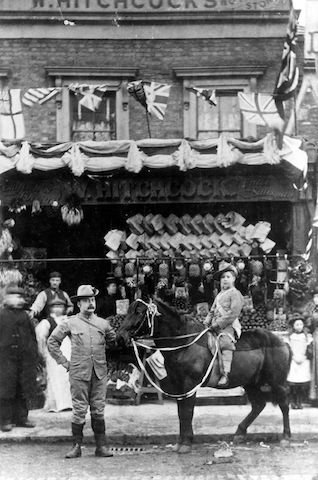
William Hitchcock, probably with his first son, William, outside the family shop in London, c. 1900; the sign above the store says "W. Hitchcock". The Hitchcocks used the pony to deliver groceries.
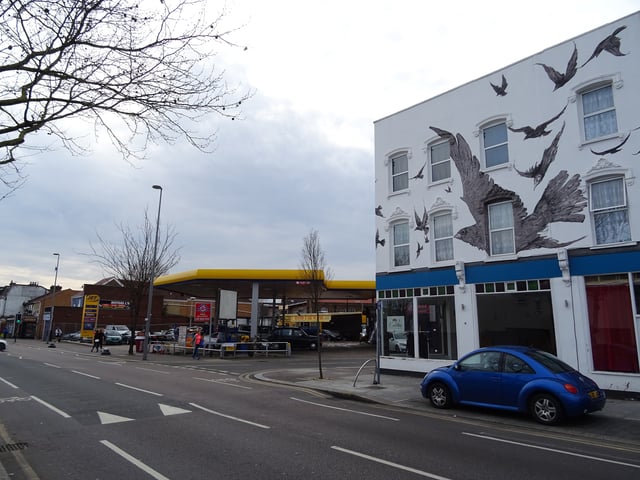
Petrol station at the site of 517 High Road, Leytonstone, where Hitchcock was born; commemorative mural at nos. 527–533 (right).[32]
Hitchcock was born on 13 August 1899 in the flat above his parents' leased grocer's shop at 517 High Road, Leytonstone, on the outskirts of east London (then part of Essex), the youngest of three children: William Daniel (born 1890), Ellen Kathleen ("Nellie") (1892), and Alfred Joseph (1899). His parents, Emma Jane Hitchcock, née Whelan (1863–1942), and William Edgar Hitchcock (1862–1914), were both Roman Catholics, with partial roots in Ireland;[23][24] William was a greengrocer as his father had been.[25] There was a large extended family, including Uncle John Hitchcock with his five-bedroom Victorian house on Campion Road, Putney, complete with maid, cook, chauffeur and gardener. Every summer John rented a seaside house for the family in Cliftonville, Kent. Hitchcock said that he first became class-conscious there, noticing the differences between tourists and locals.[26]
Describing himself as a well-behaved boy—his father called him his "little lamb without a spot"—Hitchcock said he could not remember ever having had a playmate.[27] One of his favourite stories for interviewers was about his father sending him to the local police station with a note when he was five; the policeman looked at the note and locked him in a cell for a few minutes, saying, "This is what we do to naughty boys." The experience left him, he said, with a lifelong fear of policemen; in 1973 he told Tom Snyder that he was "scared stiff of anything ... to do with the law" and wouldn't even drive a car in case he got a parking ticket.[28]
When he was six, the family moved to Limehouse and leased two stores at 130 and 175 Salmon Lane, which they ran as a fish-and-chips shop and fishmongers' respectively; they lived above the former.[29] It seems that Hitchcock was seven when he attended his first school, the Howrah House Convent in Poplar, which he entered in 1907.[30] According to Patrick McGilligan, he stayed at Howrah House for at most two years. He also attended a convent school, the Wode Street School "for the daughters of gentlemen and little boys", run by the Faithful Companions of Jesus; briefly attended a primary school near his home; and was for a very short time, when he was nine, a boarder at Salesian College in Battersea.[31]
The family moved again when he was 11, this time to Stepney, and on 5 October 1910 Hitchcock was sent to St Ignatius College in Stamford Hill, Tottenham (now in the London Borough of Haringey), a Jesuit grammar school with a reputation for discipline.[33] The priests used a hard rubber cane on the boys, always at the end of the day, so the boys had to sit through classes anticipating the punishment once they knew they'd been written up for it. He said it was here that he developed his sense of fear.[34] The school register lists his year of birth as 1900 rather than 1899; Spoto writes that it seems he was deliberately enrolled as a 10-year-old, perhaps because he was a year behind with his schooling.[35] While biographer Gene Adair reports that Hitchcock was "an average, or slightly above-average, pupil",[36] Hitchcock said he was "usually among the four or five at the top of the class";[37] at the end of his first year, his work in Latin, English, French and religious education was noted.[38] His favourite subject was geography, and he became interested in maps, and railway and bus timetables; according to Taylor, he could recite all the stops on the Orient Express.[39] He told Peter Bogdanovich: "The Jesuits taught me organization, control and, to some degree, analysis."[36]
Henley's
Hitchcock told his parents that he wanted to be an engineer,[37] and on 25 July 1913,[40] he left St Ignatius and enrolled in night classes at the London County Council School of Engineering and Navigation in Poplar. In a book-length interview in 1962, he told François Truffaut that he had studied "mechanics, electricity, acoustics, and navigation".[37] Then on 12 December 1914 his father, who had been suffering from emphysema and kidney disease, died at the age of 52.[41] To support himself and his mother—his older siblings had left home by then—Hitchcock took a job, for 15 shillings a week (£71 in 2017),[42] as a technical clerk at the Henley Telegraph and Cable Company in Blomfield Street near London Wall.[43] He kept up his night classes, this time in art history, painting, economics, and political science.[44] His older brother ran the family shops, while he and his mother continued to live in Salmon Lane.[45]
Hitchcock was too young to enlist when the First World War broke out in July 1914, and when he reached the required age of 18 in 1917, he received a C3 classification ("free from serious organic disease, able to stand service conditions in garrisons at home ... only suitable for sedentary work").[46] He joined a cadet regiment of the Royal Engineers and took part in theoretical briefings, weekend drills, and exercises. John Russell Taylor wrote that, in one session of practical exercises in Hyde Park, Hitchcock was required to wear puttees. He could never master wrapping them around his legs, and they repeatedly fell down around his ankles.[47]
After the war, Hitchcock began dabbling in creative writing. In June 1919 he became a founding editor and business manager of Henley's in-house publication, The Henley Telegraph (sixpence a copy), to which he submitted several short stories.[48][4] Henley's promoted him to the advertising department, where he wrote copy and drew graphics for advertisements for electric cable. He apparently loved the job and would stay late at the office to examine the proofs; he told Truffaut that this was his "first step toward cinema".[37][56] He enjoyed watching films, especially American cinema, and from the age of 16 read the trade papers; he watched Charlie Chaplin, D. W. Griffith and Buster Keaton, and particularly liked Fritz Lang's Der müde Tod (1921).[37]
Inter-war career: 1919–1939
Famous Players-Lasky
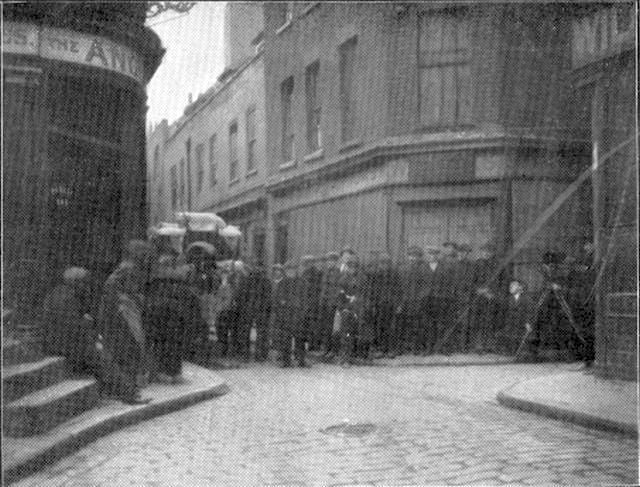
Hitchcock (right) during the making of Number 13 in London
While still at Henley's, he read in a trade paper that Famous Players-Lasky, the production arm of Paramount Pictures, was opening a studio in London.[57] They were planning to film The Sorrows of Satan by Marie Corelli, so he produced some drawings for the title cards and sent his work to the studio.[58] They hired him, and in 1919 he began working for Islington Studios in Poole Street, Hoxton, as a title-card designer.[57] Donald Spoto writes that most of the staff were Americans with strict job specifications, but the English workers were encouraged to try their hand at anything, which meant that Hitchcock gained experience as a co-writer, art director and production manager on at least 18 silent films.[59] The Times wrote in February 1922 about the studio's "special art title department under the supervision of Mr. A. J. Hitchcock".[60] His work there included Number 13 (1922), also known as Mrs. Peabody, cancelled because of financial problems—the few finished scenes are lost[61]—and Always Tell Your Wife (1923), which he and Seymour Hicks finished together when Hicks was about to give up on it.[57] Hicks wrote later about being helped by "a fat youth who was in charge of the property room ... [n]one other than Alfred Hitchcock".[62]
Gainsborough Pictures
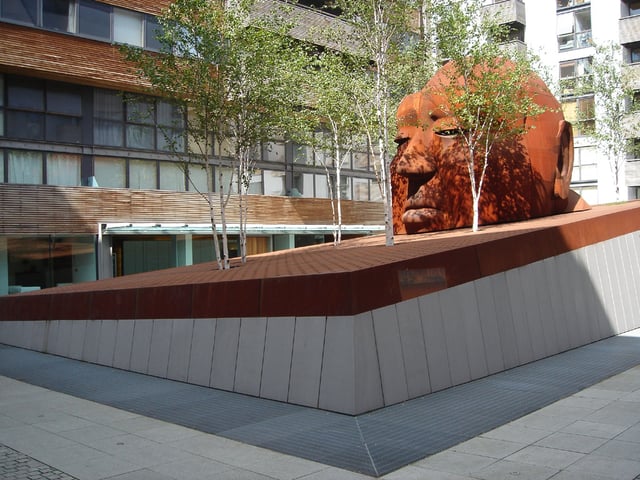
Hitchcock sculpture at the site of Gainsborough Pictures, Poole Street, Hoxton[63]
When Paramount pulled out of London in 1922, Hitchcock was hired as an assistant director by a new firm run in the same location by Michael Balcon, later known as Gainsborough Pictures.[57][64] Hitchcock worked on Woman to Woman (1923) with the director Graham Cutts, designing the set, writing the script and producing. He said: "It was the first film that I had really got my hands onto."[64] The editor and "script girl" on Woman to Woman was Alma Reville, his future wife. He also worked as an assistant to Cutts on The White Shadow (1924), The Passionate Adventure (1924), The Blackguard (1925), and The Prude's Fall (1925).[65] The Blackguard was produced at the Babelsberg Studios in Potsdam, where Hitchcock watched part of the making of F. W. Murnau's film The Last Laugh (1924).[66] He was impressed with Murnau's work and later used many of his techniques for the set design in his own productions.[67]
In the summer of 1925, Balcon asked Hitchcock to direct The Pleasure Garden (1925), starring Virginia Valli, a co-production of Gainsborough and the German firm Emelka at the Geiselgasteig studio near Munich. Reville, by then Hitchcock's fiancée, was assistant director-editor.[68][61] Although the film was a commercial flop,[69] Balcon liked Hitchcock's work; a Daily Express headline called him the "Young man with a master mind".[70] Balcon asked him to direct a second film in Munich, The Mountain Eagle (1926), based on an original story titled Fear o' God.[71] The film is lost; Hitchcock called it "a very bad movie".[70][72]
Hitchcock's luck changed with his first thriller, The Lodger: A Story of the London Fog (1927), about the hunt for a serial killer who, wearing a black cloak and carrying a black bag, is murdering young blonde women in London, and only on Tuesdays.[73] A landlady suspects that her lodger is the killer, but he turns out to be innocent. To convey the impression footsteps were being heard from an upper floor, Hitchcock had a glass floor made so that the audience could see the lodger pacing up and down in his room above the landlady.[74] Hitchcock had wanted the leading man to be guilty, or for the film at least to end ambiguously, but the star was Ivor Novello, a matinée idol, and the "star system" meant that Novello could not be the villain. Hitchcock told Truffaut: "You have to clearly spell it out in big letters: 'He is innocent.'" (He had the same problem years later with Cary Grant in Suspicion (1941).)[75]
Released in January 1927, The Lodger was a commercial and critical success in the UK.[76] Hitchcock told Truffaut that the film was the first of his to be influenced by the Expressionist techniques he had witnessed in Germany: "In truth, you might almost say that The Lodger was my first picture."[77] He made his first cameo appearance in the film because an extra was needed, and was depicted sitting in a newsroom. A second appearance, standing in a crowd as the leading man is arrested, is in doubt.[78][79]
Marriage
On 2 December 1926, Hitchcock and Alma Reville (1899–1982) married at the Brompton Oratory in South Kensington.[80] The couple honeymooned in Paris, Lake Como and St. Moritz, before returning to London to live in a leased flat on the top two floors of 153 Cromwell Road, Kensington.[81] Reville, who was born just hours after Hitchcock,[82] converted from Protestantism to Catholicism, apparently at the insistence of Hitchcock's mother; she was baptized on 31 May 1927 and confirmed at Westminster Cathedral by Cardinal Francis Bourne on 5 June.[83]
In 1928, when they learned that she was pregnant, the Hitchcocks purchased "Winter's Grace", a Tudor farmhouse set in 11 acres on Stroud Lane, Shamley Green, Surrey, for £2,500.[84] Their daughter and only child, Patricia Alma Hitchcock, was born on 7 July that year.[85] Reville became her husband's closest collaborator; Charles Champlin wrote in 1982: "The Hitchcock touch had four hands, and two were Alma's."[86][5]
Early sound films
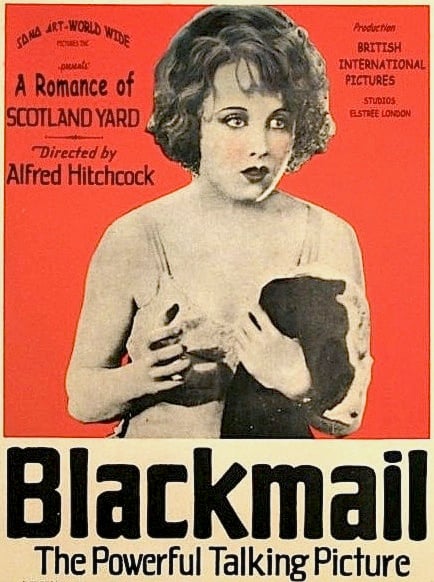
Advertisement for Blackmail (1929)

Alma Reville, Joan Harrison, Hitchcock, and Patricia Hitchcock, 24 August 1937
Hitchcock began work on his tenth film, Blackmail (1929), when its production company, British International Pictures (BIP), converted its Elstree studios to sound. The film was the first British "talkie"; it followed the first American sound feature film, The Jazz Singer (1927).[15] Blackmail began the Hitchcock tradition of using famous landmarks as a backdrop for suspense sequences, with the climax taking place on the dome of the British Museum.[88] It also features one of his longest cameo appearances, which shows him being bothered by a small boy as he reads a book on the London Underground.[89] In the PBS series The Men Who Made The Movies, Hitchcock explained how he used early sound recording as a special element of the film, stressing the word "knife" in a conversation with the woman suspected of murder.[90] During this period, Hitchcock directed segments for a BIP revue, Elstree Calling (1930), and directed a short film, An Elastic Affair (1930), featuring two Film Weekly scholarship winners. An Elastic Affair is one of the lost films.[91]
In 1933 Hitchcock was once again working for Michael Balcon at Gaumont-British. His first film for the company, The Man Who Knew Too Much (1934), was a success; his second, The 39 Steps (1935), was acclaimed in the UK and made Hitchcock a star in the US. It also established the quintessential English "Hitchcock blonde" (Madeleine Carroll) as the template for his succession of ice-cold, elegant leading ladies. Screenwriter Robert Towne remarked, "It's not much of an exaggeration to say that all contemporary escapist entertainment begins with The 39 Steps".[92] This film was one of the first to introduce the "MacGuffin" plot device, a term coined by the English screenwriter Angus MacPhail.[93] The MacGuffin is an item or goal the protagonist is pursuing, one that otherwise has no narrative value; in The 39 Steps, the MacGuffin is a stolen set of design plans.[94]
Hitchcock released two spy thrillers in 1936. Sabotage was loosely based on Joseph Conrad's novel, The Secret Agent (1907), about a woman who discovers that her husband is a terrorist, and Secret Agent, based on two stories in Ashenden: Or the British Agent (1928) by W. Somerset Maugham.[6]
At this time, Hitchcock also became notorious for pranks against the cast and crew. These jokes ranged from simple and innocent to crazy and maniacal. For instance, he hosted a dinner party where he dyed all the food blue because, as he claimed, there weren't enough blue foods. He also had a horse delivered to the dressing room of his friend, actor Sir Gerald du Maurier.[95]
Hitchcock's next major success was The Lady Vanishes (1938), "one of the greatest train movies from the genre's golden era", according to Philip French, in which Miss Froy (May Whitty), a British spy posing as a governess, disappears on a train journey through the fictional European country of Bandrika.[96] The film saw Hitchcock receive the 1939 New York Film Critics Circle Award for Best Director, the only time he won an award for his direction.[97] Benjamin Crisler, the New York Times film critic, wrote in June 1938: "Three unique and valuable institutions the British have that we in America have not: Magna Carta, the Tower Bridge and Alfred Hitchcock, the greatest director of screen melodramas in the world."[98]
Early Hollywood years: 1939–1945
Selznick contract

Trailer for Rebecca (1940)
David O. Selznick signed Hitchcock to a seven-year contract beginning in March 1939, and the Hitchcocks moved to Hollywood.[99] In June that year Life magazine called him the "greatest master of melodrama in screen history".[100] The working arrangements with Selznick were less than ideal. Selznick suffered from constant financial problems, and Hitchcock was often unhappy about Selznick's creative control over his films. In a later interview, Hitchcock said: "[Selznick] was the Big Producer. ... Producer was king. The most flattering thing Mr. Selznick ever said about me—and it shows you the amount of control—he said I was the 'only director' he'd 'trust with a film'."[101] At the same time, Selznick complained about Hitchcock's "goddamn jigsaw cutting", which meant that the producer had to follow Hitchcock's vision of the finished product.[102]
Selznick lent Hitchcock to the larger studios more often than producing Hitchcock's films himself. Selznick made only a few films each year, as did fellow independent producer Samuel Goldwyn, so he did not always have projects for Hitchcock to direct. Goldwyn had also negotiated with Hitchcock on a possible contract, only to be outbid by Selznick. Hitchcock was quickly impressed by the superior resources of the American studios compared to the financial limits he had often faced in Britain.[103]
The Selznick picture Rebecca (1940) was Hitchcock's first American film, set in a Hollywood version of England's Cornwall and based on a novel by English novelist Daphne du Maurier. The film stars Laurence Olivier and Joan Fontaine. The story concerns a naïve (and unnamed) young woman who marries a widowed aristocrat. She goes to live in his huge English country house, and struggles with the lingering reputation of his elegant and worldly first wife Rebecca, who died under mysterious circumstances. The film won Best Picture at the 13th Academy Awards; the statuette was given to Selznick, as the film's producer. Hitchcock was nominated for Best Director, his first of five such nominations.[16][104]
Hitchcock's second American film was the thriller Foreign Correspondent (1940), set in Europe, based on Vincent Sheean's book Personal History (1935) and produced by Walter Wanger. It was nominated for Best Picture that year. Hitchcock felt uneasy living and working in Hollywood while his country was at war; his concern resulted in a film that overtly supported the British war effort.[105] Filmed in the first year of the Second World War, it was inspired by the rapidly changing events in Europe, as covered by an American newspaper reporter played by Joel McCrea. Mixing footage of European scenes with scenes filmed on a Hollywood backlot, the film avoided direct references to Nazism, Nazi Germany, and Germans to comply with Hollywood's Motion Picture Production Code censorship at the time.[106]
Early war years

Cary Grant and Joan Fontaine in a publicity shot for Suspicion (1941)

Shadow of a Doubt (1943) trailer with Joseph Cotten and Teresa Wright
In September 1940 the Hitchcocks bought the 200-acre (0.81 km2) Cornwall Ranch near Scotts Valley, California, in the Santa Cruz Mountains.[107] Their primary residence was an English-style home in Bel Air, purchased in 1942.[108] Hitchcock's films were diverse during this period, ranging from the romantic comedy Mr. & Mrs. Smith (1941) to the bleak film noir Shadow of a Doubt (1943).
Suspicion (1941) marked Hitchcock's first film as a producer and director. It is set in England; Hitchcock used the north coast of Santa Cruz for the English coastline sequence. The film is the first of four projects on which Cary Grant worked with Hitchcock, and it is one of the rare occasions that Grant was cast in a sinister role. Grant plays Johnnie Aysgarth, an English con man whose actions raise suspicion and anxiety in his shy young English wife, Lina McLaidlaw (Joan Fontaine).[109] In one scene Hitchcock placed a light inside a glass of milk, perhaps poisoned, that Grant is bringing to his wife; the light makes sure that the audience's attention is on the glass. Grant's character is a killer in the book on which the film was based, Before the Fact by Francis Iles, but the studio felt that Grant's image would be tarnished by that. Hitchcock therefore settled for an ambiguous finale, although, as he told François Truffaut, he would have preferred to end with the wife's murder.[110][7] Fontaine won Best Actress for her performance.[112]
Saboteur (1942) is the first of two films that Hitchcock made for Universal during the decade. Hitchcock was forced by Universal Studios to use Universal contract player Robert Cummings and Priscilla Lane, a freelancer who signed a one-picture deal with Universal, both known for their work in comedies and light dramas.[113] Breaking with Hollywood conventions of the time, Hitchcock did extensive location filming, especially in New York City, and depicted a confrontation between a suspected saboteur (Cummings) and a real saboteur (Norman Lloyd) atop the Statue of Liberty. He also directed Have You Heard? (1942), a photographic dramatisation for Life magazine of the dangers of rumours during wartime.[114] In 1943 he wrote a mystery story for Look magazine, "The Murder of Monty Woolley",[115] a sequence of captioned photographs inviting the reader to find clues to the murderer's identity; Hitchcock cast the performers as themselves, such as Woolley, Doris Merrick, and make-up man Guy Pearce.
Shadow of a Doubt (1943) was Hitchcock's personal favourite and the second of the early Universal films. Charlotte "Charlie" Newton (Teresa Wright) suspects her beloved uncle Charlie Oakley (Joseph Cotten) of being a serial killer. Hitchcock again filmed extensively on location, this time in the Northern California city of Santa Rosa.[116]
Working at 20th Century Fox, Hitchcock approached John Steinbeck's with an idea for a film, which recorded the experiences of the survivors of a German U-boat attack. Steinbeck then began work on the script which would become the film Lifeboat (1944). However, Steinbeck was unhappy with the film and asked that his name be removed from the credits, to no avail. The idea was rewritten as a short story by Harry Sylvester and published in Collier's in 1943. The action sequences were shot in a small boat in the studio water tank. The locale posed problems for Hitchcock's traditional cameo appearance. That was solved by having Hitchcock's image appear in a newspaper that William Bendix is reading in the boat, showing the director in a before-and-after advertisement for "Reduco-Obesity Slayer".[117] He told Truffaut in 1962:
At the time, I was on a strenuous diet, painfully working my way from three hundred to two hundred pounds. So I decided to immortalize my loss and get my bit part by posing for "before" and "after" pictures. ... I was literally submerged by letters from fat people who wanted to know where and how they could get Reduco.[118]
Hitchcock's typical dinner before the weight loss had been a roast chicken, boiled ham, potatoes, bread, vegetables, relishes, salad, dessert, a bottle of wine and some brandy. To lose weight, he stopped drinking, drank black coffee for breakfast and lunch, and ate steak and salad for dinner, but it was hard to maintain; Spoto writes that his weight fluctuated considerably over the next 40 years. At the end of 1943, despite the weight loss, the Occidental Insurance Company of Los Angeles refused him life insurance.[119]
Wartime non-fiction films
"I felt the need to make a little contribution to the war effort, and I was both overweight and over-age for military service. I knew that if I did nothing, I'd regret it for the rest of my life ..." — Alfred Hitchcock (1967)[120]
Hitchcock returned to the UK for an extended visit in late 1943 and early 1944. While there he made two short propaganda films, Bon Voyage (1944) and Aventure Malgache (1944), for the Ministry of Information. In June and July 1945 Hitchcock served as "treatment advisor" on a Holocaust documentary that used Allied Forces footage of the liberation of Nazi concentration camps. The film was assembled in London and produced by Sidney Bernstein of the Ministry of Information, who brought Hitchcock (a friend of his) on board. It was originally intended to be broadcast to the Germans, but the British government deemed it too traumatic to be shown to a shocked post-war population. Instead, it was transferred in 1952 from the British War Office film vaults to London's Imperial War Museum and remained unreleased until 1985, when an edited version was broadcast as an episode of PBS Frontline, under the title the Imperial War Museum had given it: Memory of the Camps. The full-length version of the film, German Concentration Camps Factual Survey, was restored in 2014 by scholars at the Imperial War Museum.[121][122][123]
Post-war Hollywood years: 1945–1953
Later Selznick films
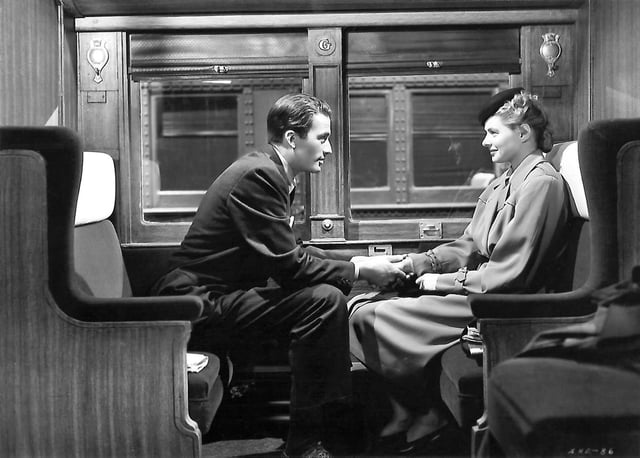
Gregory Peck and Ingrid Bergman in Spellbound (1945)
Hitchcock worked for David Selznick again when he directed Spellbound (1945), which explores psychoanalysis and features a dream sequence designed by Salvador Dalí.[124] The dream sequence as it appears in the film is ten minutes shorter than was originally envisioned; Selznick edited it to make it "play" more effectively.[125] Gregory Peck plays amnesiac Dr. Anthony Edwardes under the treatment of analyst Dr. Peterson (Ingrid Bergman), who falls in love with him while trying to unlock his repressed past.[126] Two point-of-view shots were achieved by building a large wooden hand (which would appear to belong to the character whose point of view the camera took) and out-sized props for it to hold: a bucket-sized glass of milk and a large wooden gun. For added novelty and impact, the climactic gunshot was hand-coloured red on some copies of the black-and-white film. The original musical score by Miklós Rózsa makes use of the theremin, and some of it was later adapted by the composer into Rozsa's Piano Concerto Op. 31 (1967) for piano and orchestra.[127]
Notorious (1946) followed Spellbound. Hitchcock told François Truffaut that Selznick had sold him, Ingrid Bergman, Cary Grant, and the screenplay by Ben Hecht, to RKO Radio Pictures as a "package" for $500,000 (equivalent to $6,424,061 in 2018) because of cost overruns on Selznick's Duel in the Sun (1946). Notorious stars Bergman and Grant, both Hitchcock regulars, and features a plot about Nazis, uranium and South America. His prescient use of uranium as a plot device led to him being briefly placed under surveillance by the Federal Bureau of Investigation. According to McGilligan, in or around March 1945 Hitchcock and Ben Hecht consulted Robert Millikan of the California Institute of Technology about the development of a uranium bomb. Selznick complained that the notion was "science fiction", only to be confronted by the news of the detonation of two atomic bombs on Hiroshima and Nagasaki in Japan in August 1945.[128]
Transatlantic Pictures
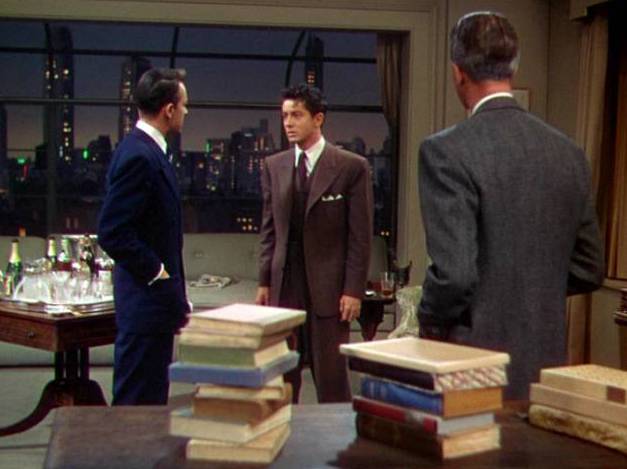
A typical shot from Rope (1948) with James Stewart turning his back to the fixed camera
Hitchcock formed an independent production company, Transatlantic Pictures, with his friend Sidney Bernstein. He made two films with Transatlantic, one of which was his first colour film. With Rope (1948), Hitchcock experimented with marshalling suspense in a confined environment, as he had done earlier with Lifeboat (1944). The film appears to have been shot in a single take, but it was actually shot in 10 takes ranging from 4-1⁄2 to 10 minutes each; a 10-minute length of film was the most that a camera's film magazine could hold at the time. Some transitions between reels were hidden by having a dark object fill the entire screen for a moment. Hitchcock used those points to hide the cut, and began the next take with the camera in the same place. The film features James Stewart in the leading role, and was the first of four films that Stewart made with Hitchcock. It was inspired by the Leopold and Loeb case of the 1920s. The film was not well received.[129]
Under Capricorn (1949), set in 19th-century Australia, also uses the short-lived technique of long takes, but to a more limited extent. He again used Technicolor in this production, then returned to black-and-white films for several years. Transatlantic Pictures became inactive after these two unsuccessful films.[130][131] Hitchcock filmed Stage Fright (1950) at studios in Elstree, England, where he had worked during his British International Pictures contract many years before.[132] He matched one of Warner Bros.' most popular stars, Jane Wyman, with the expatriate German actor Marlene Dietrich and used several prominent British actors, including Michael Wilding, Richard Todd and Alastair Sim.[133] This was Hitchcock's first proper production for Warner Bros., which had distributed Rope and Under Capricorn, because Transatlantic Pictures was experiencing financial difficulties.[134]
His film Strangers on a Train (1951) was based on the novel of the same name by Patricia Highsmith. Hitchcock combined many elements from his preceding films. He approached Dashiell Hammett to write the dialogue, but Raymond Chandler took over, then left over disagreements with the director. In the film, two men casually meet, one of whom speculates on a foolproof method to murder; he suggests that two people, each wishing to do away with someone, should each perform the other's murder. Farley Granger's role was as the innocent victim of the scheme, while Robert Walker, previously known for "boy-next-door" roles, played the villain.[135] I Confess (1953) was set in Quebec with Montgomery Clift as a Catholic priest.[136]
Peak years: 1954–1964
Dial M for Murder and Rear Window

James Stewart and Grace Kelly in Rear Window (1954)
I Confess was followed by three colour films starring Grace Kelly: Dial M for Murder (1954), Rear Window (1954), and To Catch a Thief (1955). In Dial M for Murder, Ray Milland plays the villain who tries to murder his unfaithful wife (Kelly) for her money. She kills the hired assassin in self-defence, so Milland manipulates the evidence to make it look like murder. Her lover, Mark Halliday (Robert Cummings), and Police Inspector Hubbard (John Williams) save her from execution.[137] Hitchcock experimented with 3D cinematography for Dial M.[138]
Hitchcock moved to Paramount Pictures and filmed Rear Window (1954), starring James Stewart and Kelly again, as well as Thelma Ritter and Raymond Burr. Stewart's character is a photographer (based on Robert Capa) who must temporarily use a wheelchair. Out of boredom, he begins observing his neighbours across the courtyard, then becomes convinced that one of them (Raymond Burr) has murdered his wife. Stewart eventually manages to convince his policeman buddy (Wendell Corey) and his girlfriend (Kelly). As with Lifeboat and Rope, the principal characters are depicted in confined or cramped quarters, in this case Stewart's studio apartment. Hitchcock uses close-ups of Stewart's face to show his character's reactions, "from the comic voyeurism directed at his neighbours to his helpless terror watching Kelly and Burr in the villain's apartment".[139]
Alfred Hitchcock Presents
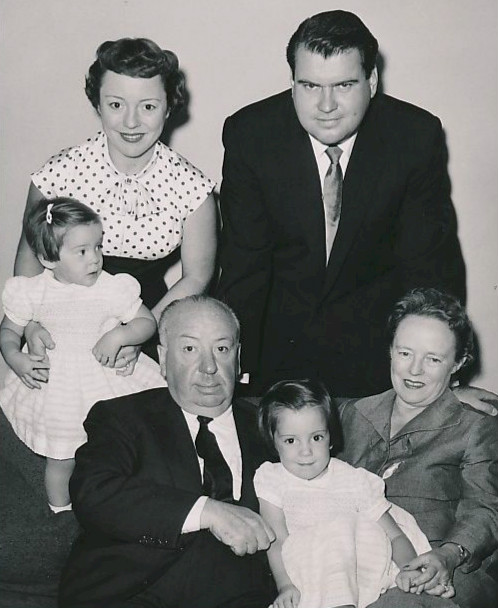
Pat Hitchcock with her daughter Terry and husband Joseph O'Connell, Alma Reville, Mary Alma O'Connell, Alfred Hitchcock (clockwise from top left), c. 1955–1956
From 1955 to 1965, Hitchcock was the host of the television series Alfred Hitchcock Presents.[140] With his droll delivery, gallows humour and iconic image, the series made Hitchcock a celebrity. The title-sequence of the show pictured a minimalist caricature of his profile (he drew it himself; it is composed of only nine strokes), which his real silhouette then filled. The series theme tune was Funeral March of a Marionette by the French composer Charles Gounod (1818–1893).[141]
His introductions always included some sort of wry humour, such as the description of a recent multi-person execution hampered by having only one electric chair, while two are shown with a sign "Two chairs—no waiting!" He directed 18 episodes of the series, which aired from 1955 to 1965. It became The Alfred Hitchcock Hour in 1962, and NBC broadcast the final episode on 10 May 1965. In the 1980s, a new version of Alfred Hitchcock Presents was produced for television, making use of Hitchcock's original introductions in a colourised form.[140]
From To Catch a Thief to Vertigo

Cameo appearance of Hitchcock next to Grant in his To Catch a Thief
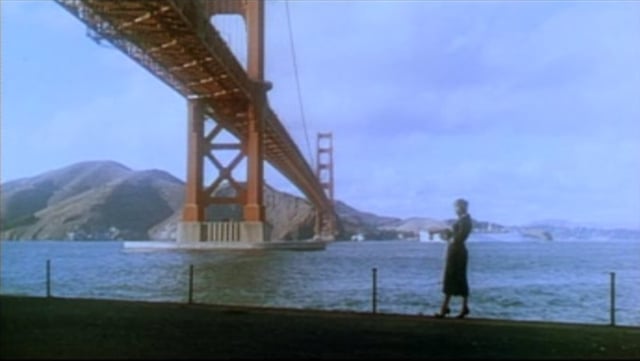
Kim Novak by the Golden Gate Bridge in Vertigo (1958)[8]
In 1955 Hitchcock became a United States citizen.[142] The same year, his third Grace Kelly film, To Catch a Thief, was released; it is set in the French Riviera, and pairs Kelly with Cary Grant. Grant plays retired thief John Robie, who becomes the prime suspect for a spate of robberies in the Riviera. A thrill-seeking American heiress played by Kelly surmises his true identity and tries to seduce him. "Despite the obvious age disparity between Grant and Kelly and a lightweight plot, the witty script (loaded with double entendres) and the good-natured acting proved a commercial success."[143] It was Hitchcock's last film with Kelly. She married Prince Rainier of Monaco in 1956, and ended her film career. Hitchcock then remade his own 1934 film The Man Who Knew Too Much in 1956. This time, the film starred James Stewart and Doris Day, who sang the theme song "Que Sera, Sera", which won the Oscar for Best Original Song and became a big hit for her. They play a couple whose son is kidnapped to prevent them from interfering with an assassination. As in the 1934 film, the climax takes place at the Royal Albert Hall, London.[144]
The Wrong Man (1957), Hitchcock's final film for Warner Bros., is a low-key black-and-white production based on a real-life case of mistaken identity reported in Life magazine in 1953. This was the only film of Hitchcock to star Henry Fonda, playing a Stork Club musician mistaken for a liquor store thief, who is arrested and tried for robbery while his wife (Vera Miles) emotionally collapses under the strain. Hitchcock told Truffaut that his lifelong fear of the police attracted him to the subject and was embedded in many scenes.[145]
Hitchcock's next film, Vertigo (1958) again starred James Stewart, this time with Kim Novak and Barbara Bel Geddes. He had wanted Vera Miles to play the lead, but she was pregnant. He told Oriana Fallaci: "I was offering her a big part, the chance to become a beautiful sophisticated blonde, a real actress. We'd have spent a heap of dollars on it, and she has the bad taste to get pregnant. I hate pregnant women, because then they have children."[146]
In the film, James Stewart plays Scottie, a former police investigator suffering from acrophobia, who develops an obsession with a woman he has been hired to shadow (Kim Novak). Scottie's obsession leads to tragedy, and this time Hitchcock does not opt for a happy ending. Some critics, including Donald Spoto and Roger Ebert, agree that Vertigo is the director's most personal and revealing film, dealing with the Pygmalion-like obsessions of a man who crafts a woman into the woman he desires. Vertigo explores more frankly and at greater length his interest in the relation between sex and death than any other work in his filmography.[147]
Vertigo contains a camera technique developed by Irmin Roberts, commonly referred to as a dolly zoom, that has been copied many times by filmmakers. The film premiered at the San Sebastián International Film Festival, where Hitchcock won a Silver Seashell.[148] Vertigo is considered a classic, but it attracted some negative reviews and poor box-office receipts at the time, and it was the last collaboration between Stewart and Hitchcock.[149] In the 2002 Sight & Sound polls, it ranked just behind Citizen Kane (1941); ten years later, in the same magazine, critics chose it as the best film ever made.[19]
North by Northwest and Psycho
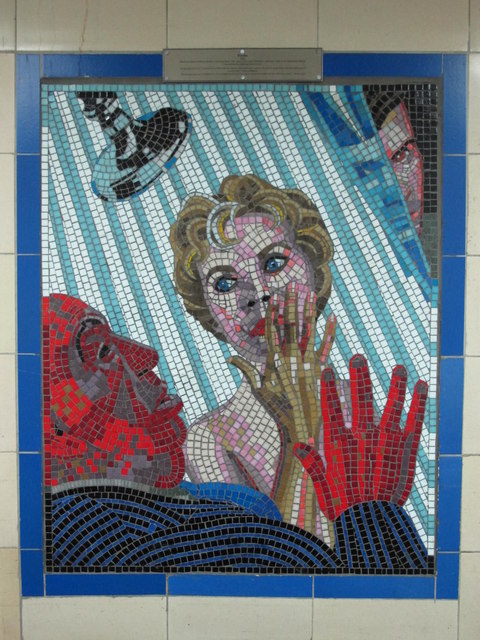
Psycho mosaic in the Hitchcock Gallery at Leytonstone tube station
Hitchcock followed Vertigo with three more successful films, which are also recognised as among his best: North by Northwest (1959), Psycho (1960) and The Birds (1963). In North by Northwest, Cary Grant portrays Roger Thornhill, a Madison Avenue advertising executive who is mistaken for a government secret agent. He is hotly pursued across the United States by enemy agents, including (it appears) Eve Kendall (Eva Marie Saint). Thornhill at first believes Kendall is helping him, then that she is an enemy agent; he eventually learns that she is working undercover for the CIA. During its opening two-week run at Radio City Music Hall, the film grossed $404,056 (equivalent to $3,472,760 in 2018), setting a record in that theatre's non-holiday gross.[150] Time magazine called the film "smoothly troweled and thoroughly entertaining".[151]
Psycho (1960) is arguably Hitchcock's best-known film.[152] Based on Robert Bloch's novel Psycho (1959), which was inspired by the case of Ed Gein,[153] the film was produced on a constrained budget of $800,000 (equivalent to $6,775,253 in 2018) and shot in black-and-white on a spare set using crew members from Alfred Hitchcock Presents.[154] The unprecedented violence of the shower scene,[9] the early death of the heroine, and the innocent lives extinguished by a disturbed murderer became the hallmarks of a new horror-film genre.[156] The public loved the film, with lines stretching outside cinemas as people had to wait for the next showing. It broke box-office records in the United Kingdom, France, South America, the United States and Canada and was a moderate success in Australia for a brief period.[130]
The film was the most profitable of Hitchcock's career; he personally earned well in excess of $15 million (equivalent to $127.04 million in 2018). He subsequently swapped his rights to Psycho and his TV anthology for 150,000 shares of MCA, making him the third largest shareholder and his own boss at Universal, in theory at least, although that did not stop them from interfering with him.[130][131] Following the first film, Psycho became an American horror franchise: Psycho II, Psycho III, Bates Motel, Psycho IV: The Beginning, and a colour 1998 remake of the original.[157]
Truffaut interview
On 13 August 1962, Hitchcock's 63rd birthday, the French director François Truffaut began a 50-hour interview of Hitchcock, filmed over eight days at Universal Studios, during which Hitchcock agreed to answer 500 questions. It took four years to transcribe the tapes and organize the images; it was published as a book in 1967, which Truffaut nicknamed the "Hitchbook". The audio tapes were used as the basis of a documentary in 2015.[158][159] Truffaut sought the interview because it was clear to him that Hitchcock was not simply the mass-market entertainer the American media made him out to be. It was obvious from his films, Truffaut wrote, that Hitchcock had "given more thought to the potential of his art than any of his colleagues". He compared the interview to "Oedipus' consultation of the oracle".[160]
The Birds

Trailer for The Birds (1963), in which Hitchcock discusses humanity's treatment of "our feathered friends"
The film scholar Peter William Evans writes that The Birds (1963) and Marnie (1964) are regarded as "undisputed masterpieces".[129] Hitchcock had intended to film Marnie first, and in March 1962 it was announced that Grace Kelly, Princess Grace of Monaco since 1956, would come out of retirement to star in it.[161] When Kelly asked Hitchcock to postpone Marnie until 1963 or 1964, he recruited Evan Hunter, author of The Blackboard Jungle (1954), to develop a screenplay based on a Daphne du Maurier short story, "The Birds" (1952), which Hitchcock had republished in his My Favorites in Suspense (1959). He hired Tippi Hedren to play the lead role.[162] It was her first role; she had been a model in New York when Hitchcock saw her, in October 1961, in an NBC television ad for Sego, a diet drink:[163] "I signed her because she is a classic beauty. Movies don't have them any more. Grace Kelly was the last." He insisted, without explanation, that her first name be written in single quotation marks: 'Tippi'.[10]
In The Birds, Melanie Daniels, a young socialite, meets lawyer Mitch Brenner (Rod Taylor) in a bird shop; Jessica Tandy plays his possessive mother. Hedren visits him in Bodega Bay (where The Birds was filmed)[164] carrying a pair of lovebirds as a gift. Suddenly waves of birds start gathering, watching, and attacking. The question: "What do the birds want?" is left unanswered.[166] Hitchcock made the film with equipment from the Revue Studio, which made Alfred Hitchcock Presents. He said it was his most technically challenging film yet, using a combination of trained and mechanical birds against a backdrop of wild ones. Every shot was sketched in advance.[164]
An HBO/BBC television film, The Girl (2012), depicted Hedren's experiences on set; she said that Hitchcock became obsessed with her and sexually harassed her. He reportedly isolated her from the rest of the crew, had her followed, whispered obscenities to her, had her handwriting analysed, and had a ramp built from his private office directly into her trailer.[167][168] Diane Baker, her co-star in Marnie, said: "[N]othing could have been more horrible for me than to arrive on that movie set and to see her being treated the way she was."[169] While filming the attack scene in the attic—which took a week to film—she was placed in a caged room while two men wearing elbow-length protective gloves threw live birds at her. Toward the end of the week, to stop the birds flying away from her too soon, one leg of each bird was attached by nylon thread to elastic bands sewn inside her clothes. She broke down after a bird cut her lower eyelid, and filming was halted on doctor's orders.[170]
Marnie

Trailer for Marnie (1964)
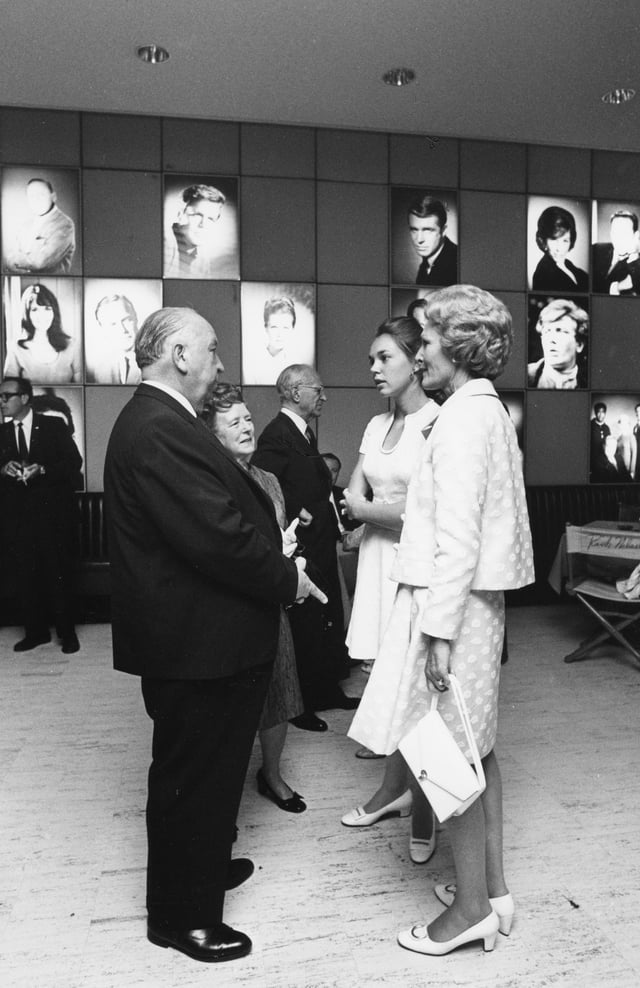
The Hitchcocks with First Lady Pat Nixon and first daughter Julie Nixon Eisenhower in 1969
In June 1962, Grace Kelly announced that she had decided against appearing in Marnie (1964). Hedren had signed an exclusive seven-year, $500-a-week contract with Hitchcock in October 1961,[171] and he decided to cast her in the lead role opposite Sean Connery. In 2016, describing Hedren's performance as "one of the greatest in the history of cinema", Richard Brody called the film a "story of sexual violence" inflicted on the character played by Hedren: "The film is, to put it simply, sick, and it's so because Hitchcock was sick. He suffered all his life from furious sexual desire, suffered from the lack of its gratification, suffered from the inability to transform fantasy into reality, and then went ahead and did so virtually, by way of his art."[172] A 1964 New York Times film review called it Hitchcock's "most disappointing film in years", citing Hedren's and Connery's lack of experience, an amateurish script and "glaringly fake cardboard backdrops".[173]
In the film, Marnie Edgar (Hedren) steals $10,000 (equivalent to $80,783 in 2018) from her employer and goes on the run. She applies for a job at Mark Rutland's (Connery) company in Philadelphia and steals from there too. Earlier she is shown having a panic attack during a thunderstorm and fearing the colour red. Mark tracks her down and blackmails her into marrying him. She explains that she does not want to be touched, but during the "honeymoon", Mark rapes her. Marnie and Mark discover that Marnie's mother had been a prostitute when Marnie was a child, and that, while the mother was fighting with a client during a thunderstorm—the mother believed the client had tried to molest Marnie—Marnie had killed the client to save her mother. Cured of her fears when she remembers what happened, she decides to stay with Mark.[172][174]
No longer speaking to her because she had rebuffed him, Hitchcock apparently referred to Hedren throughout as "the girl" rather than by name. He told Robert Burks, the cinematographer, that the camera had to be placed as close as possible to Hedren when he filmed her face.[175] Evan Hunter, the screenwriter of The Birds who was writing Marnie too, explained to Hitchcock that, if Mark loved Marnie, he would comfort her, not rape her. Hitchcock reportedly replied: "Evan, when he sticks it in her, I want that camera right on her face!"[176] When Hunter submitted two versions of the script, one without the rape scene, Hitchcock replaced him with Jay Presson Allen.[177]
Later years: 1966–1980
Final films
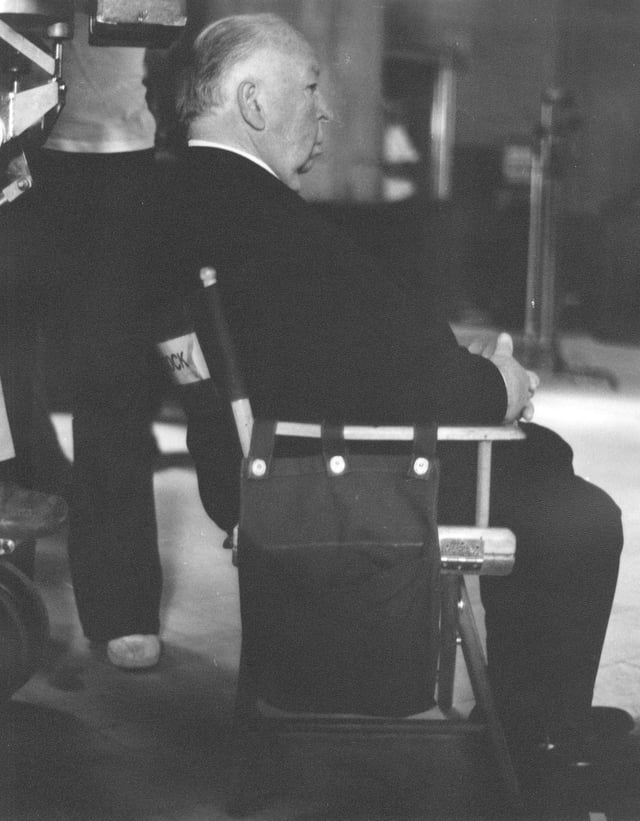
Hitchcock at work on Family Plot, San Francisco, summer 1975
Failing health reduced Hitchcock's output during the last two decades of his life. Biographer Stephen Rebello claimed Universal "forced" two movies on him, Torn Curtain (1966) and Topaz (1969).[131][130] Both were spy thrillers with Cold War-related themes. Torn Curtain, with Paul Newman and Julie Andrews, precipitated the bitter end of the 12-year collaboration between Hitchcock and composer Bernard Herrmann.[178] Hitchcock was unhappy with Herrmann's score and replaced him with John Addison, Jay Livingston and Ray Evans.[179] Topaz (1967), based on a Leon Uris novel, is partly set in Cuba. Both films received mixed reviews.[180]
Hitchcock returned to Britain to make his penultimate film, Frenzy (1972), based on the novel Goodbye Piccadilly, Farewell Leicester Square (1966). After two espionage films, the plot marked a return to the murder-thriller genre. Richard Blaney (Jon Finch), a volatile barman with a history of explosive anger, becomes the prime suspect in the investigation into the "Necktie Murders", which are actually committed by his friend Bob Rusk (Barry Foster). This time, Hitchcock makes the victim and villain kindreds, rather than opposites as in Strangers on a Train.[181]
In Frenzy, Hitchcock allowed nudity for the first time. Two scenes show naked women, one of whom is being raped and strangled;[129] Spoto called the latter "one of the most repellent examples of a detailed murder in the history of film". Both actors, Barbara Leigh-Hunt and Anna Massey, refused to do the scenes, so models were used instead.[182] Biographers have noted that Hitchcock had always pushed the limits of film censorship, often managing to fool Joseph Breen, the longtime head of Hollywood's Motion Picture Production Code. Many times Hitchcock slipped in subtle hints of improprieties forbidden by censorship until the mid-1960s. Yet McGilligan wrote that Breen and others often realised that Hitchcock was inserting such things and were actually amused, as well as alarmed by Hitchcock's "inescapable inferences".[183]
Family Plot (1976) was Hitchcock's last film. It relates the escapades of "Madam" Blanche Tyler, played by Barbara Harris, a fraudulent spiritualist, and her taxi-driver lover Bruce Dern, making a living from her phony powers. While Family Plot was based on the Victor Canning novel The Rainbird Pattern (1972), the novel's tone is more sinister. Screenwriter Ernest Lehman originally wrote the film with a dark tone but was pushed to a lighter, more comical tone by Hitchcock.
Knighthood and death
Toward the end of his life, Hitchcock was working on the script for a spy thriller, The Short Night, collaborating with James Costigan, Ernest Lehman and David Freeman. Despite preliminary work, it was never filmed. Hitchcock's health was declining and he was worried about his wife, who had suffered a stroke. The screenplay was eventually published in Freeman's book The Last Days of Alfred Hitchcock (1999).[184]
Having refused a CBE in 1962,[185] Hitchcock was appointed a Knight Commander of the Most Excellent Order of the British Empire (KBE) in the 1980 New Year Honours.[22][186] He was too ill to travel to London—he had a pacemaker and was being given cortisone injections for his arthritis—so on 3 January 1980 the British consul general presented him with the papers at Universal Studios. Asked by a reporter after the ceremony why it had taken the Queen so long, Hitchcock quipped, "I suppose it was a matter of carelessness." Cary Grant, Janet Leigh, and others attended a luncheon afterwards.[187][188]
His last public appearance was on 16 March 1980, when he introduced the next year's winner of the American Film Institute award.[187] He died of kidney failure the following month, on 29 April, in his Bel Air home.[108][189] Donald Spoto, one of Hitchcock's biographers, wrote that Hitchcock had declined to see a priest,[190] but according to Jesuit priest Mark Henninger, he and another priest, Tom Sullivan, celebrated Mass at the filmmaker's home, and Sullivan heard his confession.[191] Hitchcock was survived by his wife and daughter. His funeral was held at Good Shepherd Catholic Church in Beverly Hills on 30 April, after which his body was cremated. His remains were scattered over the Pacific Ocean on 10 May 1980.[192]
Filmmaking
Themes and motifs
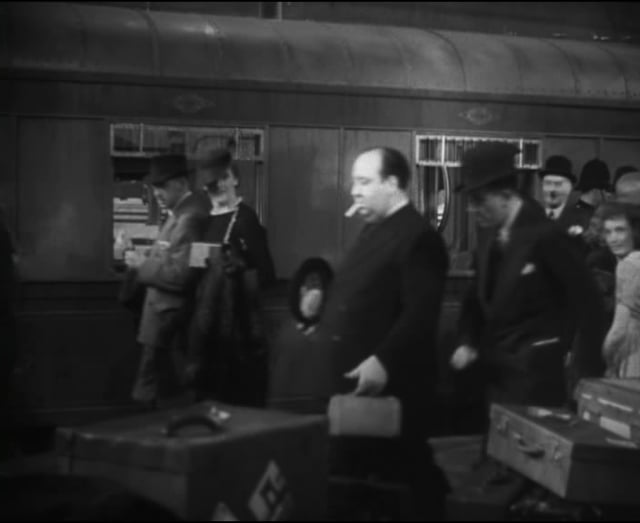
Hitchcock's cameo appearance in The Lady Vanishes (1938)
Hitchcock appears briefly in most of his own films. For example, he is seen struggling to get a double bass onto a train (Strangers on a Train), walking dogs out of a pet shop (The Birds), fixing a neighbour's clock (Rear Window), as a shadow (Family Plot), sitting at a table in a photograph (Dial M for Murder), and riding a bus (North by Northwest).[195]
Representation of women

Kim Novak and James Stewart in Vertigo (1958)
Hitchcock's portrayal of women has been the subject of much scholarly debate. Bidisha wrote in The Guardian in 2010: "There's the vamp, the tramp, the snitch, the witch, the slink, the double-crosser and, best of all, the demon mommy. Don't worry, they all get punished in the end."[196] In a widely cited essay in 1975, Laura Mulvey introduced the idea of the male gaze; the view of the spectator in Hitchcock's films, she argued, is that of the heterosexual male protagonist.[197] "The female characters in his films reflected the same qualities over and over again", Roger Ebert wrote in 1996. "They were blonde. They were icy and remote. They were imprisoned in costumes that subtly combined fashion with fetishism. They mesmerised the men, who often had physical or psychological handicaps. Sooner or later, every Hitchcock woman was humiliated."[198][11]
The victims in The Lodger are all blondes. In The 39 Steps (1935), Madeleine Carroll is put in handcuffs. Ingrid Bergman, whom Hitchcock directed three times (Spellbound (1945), Notorious (1946), and Under Capricorn (1949)), is dark blonde. In Rear Window (1954), Lisa (Grace Kelly) risks her life by breaking into Lars Thorwald's apartment. In To Catch a Thief (1955), Francie (Grace Kelly again) offers to help a man she believes is a burglar. In Vertigo (1958) and North by Northwest (1959) respectively, Kim Novak and Eva Marie Saint play the blonde heroines. In Psycho (1960), Janet Leigh's character steals $40,000 (equivalent to $338,763 in 2018) and is murdered by Norman Bates, a reclusive psychopath. Tippi Hedren, a blonde, appears to be the focus of the attacks in The Birds (1963). In Marnie (1964), the title character, again played by Hedren, is a thief. In Topaz, French actresses Dany Robin as Stafford's wife and Claude Jade as Stafford's daughter are blonde heroines, the mistress was played by brunette Karin Dor. Hitchcock's last blonde heroine was Barbara Harris as a phony psychic turned amateur sleuth in Family Plot (1976), his final film. In the same film, the diamond smuggler played by Karen Black wears a long blonde wig in several scenes.
His films often feature characters struggling in their relationships with their mothers, such as Norman Bates in Psycho. In North by Northwest (1959), Roger Thornhill (Cary Grant) is an innocent man ridiculed by his mother for insisting that shadowy, murderous men are after him. In The Birds (1963), the Rod Taylor character, an innocent man, finds his world under attack by vicious birds, and struggles to free himself from a clinging mother (Jessica Tandy). The killer in Frenzy (1972) has a loathing of women but idolises his mother. The villain Bruno in Strangers on a Train hates his father, but has an incredibly close relationship with his mother (played by Marion Lorne). Sebastian (Claude Rains) in Notorious has a clearly conflicting relationship with his mother, who is (rightly) suspicious of his new bride, Alicia Huberman (Ingrid Bergman).[200]
Relationship with actors
... I told her that my idea of a good actor or good actress is someone who can do nothing very well. ... I said, "That's one of the things you've got to learn to have ... authority." Out of authority comes control and out of control you get the range ... Whether you do little acting, a lot of acting in a given scene. You know exactly where you're going. And these were the first things that she had to know. Emotion comes later and the control of the voice comes later. But, within herself, she had to learn authority first and foremost because out of authority comes timing. — Alfred Hitchcock (1967)[201]
Hitchcock believed that actors should concentrate on their performances and leave work on script and character to the directors and screenwriters. He told Bryan Forbes in 1967: "I remember discussing with a method actor how he was taught and so forth. He said, 'We're taught using improvisation. We are given an idea and then we are turned loose to develop in any way we want to.' I said 'That's not acting. That's writing.'"[111] Walter Slezak said that Hitchcock knew the mechanics of acting better than anyone he knew.[203]
Critics observed that, despite his reputation as a man who disliked actors, actors who worked with him often gave brilliant performances. He used the same actors in many of his films; Cary Grant worked with Hitchcock four times,[204] and Ingrid Bergman three. James Mason said that Hitchcock regarded actors as "animated props".[205] For Hitchcock, the actors were part of the film's setting. He told François Truffaut: "The chief requisite for an actor is the ability to do nothing well, which is by no means as easy as it sounds. He should be willing to be utilised and wholly integrated into the picture by the director and the camera. He must allow the camera to determine the proper emphasis and the most effective dramatic highlights."[206]
Writing, storyboards and production
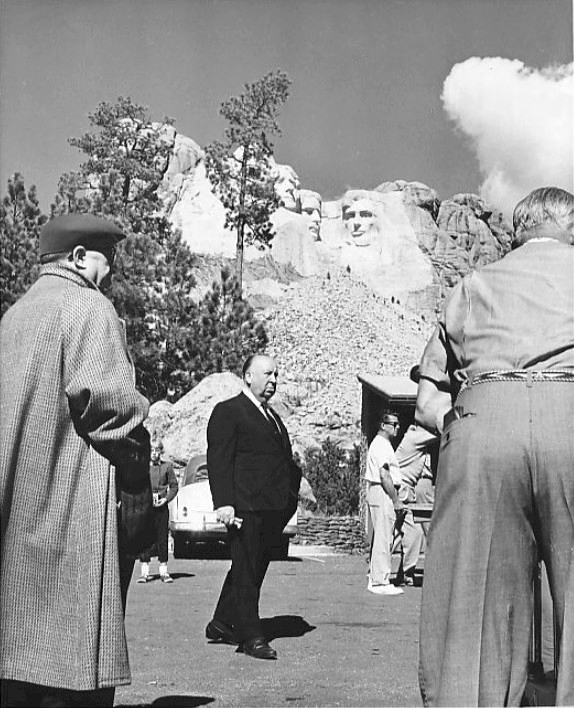
Hitchcock at Mount Rushmore filming North by Northwest (1959)

Hitchcock interview, around 1966
Hitchcock planned his scripts in detail with his writers. In Writing with Hitchcock (2001), Steven DeRosa noted that Hitchcock supervised them through every draft, asking that they tell the story visually.[207] He told Roger Ebert in 1969:
Once the screenplay is finished, I'd just as soon not make the film at all. All the fun is over. I have a strongly visual mind. I visualize a picture right down to the final cuts. I write all this out in the greatest detail in the script, and then I don't look at the script while I'm shooting. I know it off by heart, just as an orchestra conductor needs not look at the score. It's melancholy to shoot a picture. When you finish the script, the film is perfect. But in shooting it you lose perhaps 40 per cent of your original conception.[208]
Hitchcock's films were extensively storyboarded to the finest detail. He was reported to have never even bothered looking through the viewfinder, since he did not need to, although in publicity photos he was shown doing so. He also used this as an excuse to never have to change his films from his initial vision. If a studio asked him to change a film, he would claim that it was already shot in a single way, and that there were no alternative takes to consider.
This view of Hitchcock as a director who relied more on pre-production than on the actual production itself has been challenged by Bill Krohn, the American correspondent of French film magazine Cahiers du cinéma, in his book Hitchcock at Work. After investigating script revisions, notes to other production personnel written by or to Hitchcock, and other production material, Krohn observed that Hitchcock's work often deviated from how the screenplay was written or how the film was originally envisioned.[209] He noted that the myth of storyboards in relation to Hitchcock, often regurgitated by generations of commentators on his films, was to a great degree perpetuated by Hitchcock himself or the publicity arm of the studios. For example, the celebrated crop-spraying sequence of North by Northwest was not storyboarded at all. After the scene was filmed, the publicity department asked Hitchcock to make storyboards to promote the film, and Hitchcock in turn hired an artist to match the scenes in detail.[210]
Even when storyboards were made, scenes that were shot differed from them significantly. Krohn's analysis of the production of Hitchcock classics like Notorious reveals that Hitchcock was flexible enough to change a film's conception during its production. Another example Krohn notes is the American remake of The Man Who Knew Too Much, whose shooting schedule commenced without a finished script and moreover went over schedule, something that, as Krohn notes, was not an uncommon occurrence on many of Hitchcock's films, including Strangers on a Train and Topaz. While Hitchcock did do a great deal of preparation for all his films, he was fully cognisant that the actual film-making process often deviated from the best-laid plans and was flexible to adapt to the changes and needs of production as his films were not free from the normal hassles faced and common routines utilised during many other film productions.[210]
Krohn's work also sheds light on Hitchcock's practice of generally shooting in chronological order, which he notes sent many films over budget and over schedule and, more importantly, differed from the standard operating procedure of Hollywood in the Studio System Era. Equally important is Hitchcock's tendency to shoot alternative takes of scenes. This differed from coverage in that the films were not necessarily shot from varying angles so as to give the editor options to shape the film how he/she chooses (often under the producer's aegis).[211] Rather they represented Hitchcock's tendency to give himself options in the editing room, where he would provide advice to his editors after viewing a rough cut of the work. According to Krohn, this and a great deal of other information revealed through his research of Hitchcock's personal papers, script revisions and the like refute the notion of Hitchcock as a director who was always in control of his films, whose vision of his films did not change during production, which Krohn notes has remained the central long-standing myth of Alfred Hitchcock. Both his fastidiousness and attention to detail also found their way into each film poster for his films. Hitchcock preferred to work with the best talent of his day—film poster designers such as Bill Gold[212] and Saul Bass—who would produce posters that accurately represented his films.[210]
Legacy
Awards and honours

One of Hitchcock's stars on the Hollywood Walk of Fame

An English Heritage blue plaque marks where Hitchcock lived at 153 Cromwell Road, Kensington, London.
Hitchcock was inducted into the Hollywood Walk of Fame on 8 February 1960 with two stars: one for television and a second for his motion pictures.[213] In 1978 John Russell Taylor described him as "the most universally recognizable person in the world" and "a straightforward middle-class Englishman who just happened to be an artistic genius".[188] In 2002 MovieMaker named him the most influential director of all time,[214] and a 2007 The Daily Telegraph critics' poll ranked him Britain's greatest director. David Gritten, the newspaper's film critic, wrote: "Unquestionably the greatest filmmaker to emerge from these islands, Hitchcock did more than any director to shape modern cinema, which would be utterly different without him. His flair was for narrative, cruelly withholding crucial information (from his characters and from us) and engaging the emotions of the audience like no one else."[215]
He won two Golden Globes, eight Laurel Awards, and five lifetime achievement awards, including the first BAFTA Academy Fellowship Award[216] and, in 1979, an AFI Life Achievement Award.[22] He was nominated five times for an Academy Award for Best Director. Rebecca, nominated for 11 Oscars, won the Academy Award for Best Picture of 1940; another Hitchcock film, Foreign Correspondent, was also nominated that year.[217] By 2018, eight of his films had been selected for preservation by the US National Film Registry: Rebecca (1940; inducted 2018), Shadow of a Doubt (1943; inducted 1991), Notorious (1946; inducted 2006), Rear Window (1954; inducted 1997), Vertigo (1958; inducted 1989), North by Northwest (1959; inducted 1995), Psycho (1960; inducted 1992), and The Birds (1963; inducted 2016).[20]
In 2012 Hitchcock was selected by artist Sir Peter Blake, author of the Beatles' Sgt. Pepper's Lonely Hearts Club Band album cover, to appear in a new version of the cover, along with other British cultural figures, and he was featured that year in a BBC Radio 4 series, The New Elizabethans, as someone "whose actions during the reign of Elizabeth II have had a significant impact on lives in these islands and given the age its character".[218] In June 2013 nine restored versions of Hitchcock's early silent films, including The Pleasure Garden (1925), were shown at the Brooklyn Academy of Music's Harvey Theatre; known as "The Hitchcock 9", the travelling tribute was organised by the British Film Institute.[219]
Archives
The Alfred Hitchcock Collection is housed at the Academy Film Archive in Hollywood, California. It includes home movies, 16 mm film shot on the set of Blackmail (1929) and Frenzy (1972), and the earliest known colour footage of Hitchcock. The Academy Film Archive preserves many of his home movies. The Alfred Hitchcock Papers is housed at the Academy's Margaret Herrick Library.[220] The David O. Selznick and the Ernest Lehman collections housed at the Harry Ransom Humanities Research Center in Austin, Texas, contain material related to Hitchcock's work on the production of The Paradine Case, Rebecca, Spellbound, North by Northwest and Family Plot.[221]
Hitchcock portrayals
Anthony Hopkins in Hitchcock (2012)
Toby Jones in The Girl (2012)
Roger Ashton-Griffiths in Grace of Monaco (2014)
Filmography
Films
Frequently cast actors
Many of the British actors additionally appeared in some of the two dozen or so films Hitchcock worked on in other capacities, such as co-writer, title designer, art director and assistant director. For instance, Clare Greet was also in Lord Camber's Ladies (1932), which Hitchcock produced, as was Benita Hume, who had been in Easy Virtue (1928).
See also
List of film director and actor collaborations
List of unproduced Hitchcock projects
Notes and sources
Notes
References
Works cited
Biographies (chronological)
Miscellaneous
